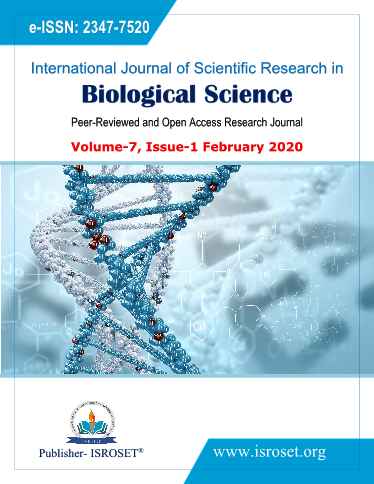A Comparative Study between Plant and Callus Extracts: Analysis of Phytochemical, Antioxidant, Antibacterial and Anticancer Properties of Ormocarpum Sennoides (Willd.) DC
Keywords:
In vivo plant, callus, phytochemicals, antioxidants, anticancerAbstract
A comparative study was conducted between the in vivo grown plant and in vitro callus of Ormocarpum sennoides (Willd.) DC using aqueous, methanol and ethyl acetate as solvents. MS medium supplemented with BAP 2.0 mg/L + IAA 3.0 mg/L has shown the highest callus induction percentage of 86.7% with the maximum callus weight of 1.03g. Ormocarpum sennoides contains a maximum of 7% total ash. The phytochemical analysis revealed that the aqueous, methanol and ethyl acetate extracts of both plant and callus showed the presence of many phytochemical compounds. FTIR analysis of plant and callus aqueous extract had a maximum characteristic band at 3403.18 cm -1 indicating the presence of O-H stretching and 3406.51 cm-1 indicating the presence of N-H stretching respectively. The GC-MS analysis of methanol extract of the plant indicates the presence of Alpha.-Methyl Mannofuranoside and Silane,[[(3.Beta.)-Gorgost-5-en-3-yl]oxy]Trimethyl-. Callus extract indicates the presence of D-Glucopyranoside, Methyl 3-O-Methyl, Ala-.Beta.-Ala, Trimethylsilyl ester and 4-Pentadecyne,15-chloro-. Plant extract exhibited maximum total phenol content and DPPH radical scavenging activity than callus extracts. Methanol and ethyl acetate plant showed a maximum zone of inhibition of 6 mm against Bacillus subtilis. While the ethyl acetate extract of both plant and callus showed a maximum zone of inhibition of 7mm against Escherichia coli. Aqueous extract of plant and callus showed a maximum zone of inhibition of 10mm and 9mm against Staphylococcus aureus respectively. Anticancer studies revealed that in vivo plant has the inhibitory percentage of 24.9% whereas callus exhibits only 9.3% as an inhibitory percentage against HeLa cells.
References
S. Ganesan, S. Parasuraman, S. U. Maheswaran, N. Gnanasekar, “Wound healing activity of Hemidesmus indicus formulation”. Journal of Pharmacology and Pharmacotherapeutics, Vol. 3, pp. 66-67, 2012.
M. Gayathri, K. Kannabiran, “Hypoglycemic activity of Hemidesmus indicus R.Br. on streptozotocin induced diabetic rats”. International Journal of Diabetes in Developing Countries, Vol. 28, pp. 6-10, 2008.
S. Sukasini, M. Bhargav Iyer, S. Sakthi Priyadarshini, P. R. Kumar, “Retrospect of Ormocarpum sennoides (willd.) DC: A Boon to phytomedicine”. Global Journal of Research on Medicinal Plants & Indigenous Medicine, Vol. 4, Issue. 10, pp. 203-208, 2015.
M. Dinesh Kumar, K. M. Maria John, S. Karthik, “The Bone Fracture Healing Potential of Ormocarpum cochinchinense methanolic extract on albino Wistar rats”. Journal of Herbs, Spices & Medicinal Plants, Vol. 19, pp. 1-10, 2013.
S. Srividya, G. Sridevi, “Anti-Arthritic and Anti-Inflammatory Activity of Ethanolic Leaf Extract of Ormocarpum sennoides”. International Journal of Pharmacy and Pharmaceutical Sciences, Vol. 8, Issue. 5, pp. 117-121, 2016
Clements R. Markham, “Travels in Peru and India: While Superintending the Collection of Chinchona Plants and Seeds in South America, and their Introduction into India”, Cambridge University Press, pp. 554, 2012.
Y.S. Kumar, S.S. Deepika, Jalalpure, S. Sainiprem, “Phytochemical screening of various extracts of stem bark of Bauhinia racemose”. International Journal of Pharmaceutical Research and Development, Vol. 2, Issue. 5, pp. 1-6, 2010.
Saikat Paul, Aryadeep Roychoudhury, “Comparative Analyses of Regeneration Potentiality of Eight Indigenous Aromatic Indica rice (Oryza sativa L.) Varieties,” International Journal of Scientific Research in Biological Sciences, Vol.6, Issue.1, pp.55-64, 2019.
R. Sujithra Devi, J. Anbumalarmathi, S. Aruna Sharmili, K.R. Santhiya, “Callus induction and micropropagation in Phyllanthus amarus”. International Journal of Herbal Technology, Vol. 1, Issue. 1, pp. 23-26, 2016.
U. Thiripurasundari, M.V. Rao, “Indirect organogenesis from nodal explants of Coccinia grandis (L.) Voigt” Indian Journal of Biotechnology,Vol. 11, pp. 352-354, 2012.
R. Sujithra Devi, J. Anbumalarmathi, S. Aruna Sharmili, “Synthesis of Copper Nanoparticles, Antibacterial Screening and Larvicidal activity of Phyllanthus amarus”. Journal of Chemical Biological and Physical Sciences, Vol. 7, Issue. 14, pp. 1239-1247, 2017.
Syed Zennat Shaheen, Krishnan Bolla, Kandukuri Vasu, M. A. Singara Charya, “Antimicrobial activity of the fruit extract of Coccinia indica”. African Journal of Biotechnology. Vol. 8, Issue. 24, pp. 7073-7076, 2009.
A. Divya, J. Anbumalarmathi, S. Aruna Sharmili, “Phytochemical Analysis of Antimicrobial and Antioxidant Activity of Clitoria ternatea Blue and White Flowered Leaves”. Advances in Research, Vol. 4, Issue. 5, pp. 1-13, 2018.
T. Sabitha, S. Aruna Sharmili, J. Anbumalarmathi, K. Umamaheshwari, K. Shyamala, M. Velvizhi, “Phytochemical analysis of Aerva lantana, Adathoda vasica, Pisonia alba, Sesbania grandiflora, and Indigofera aspalathoides”. Innovare Journal of Ayurvedic Science, Vol. 4, Issue. 3, pp. 12-15, 2016.
F. Jeniffer Usha, S. Aruna Sharmili, J. Anbumalarmathi, “Screening the Phytochemical Constituents, Antimicrobical and Antioxidant activity of Acacia nilotica, Ficus bengalensis, and Thespesia populnea” European Journal of Biomedical and Pharmaceutical Sciences, 5(3), 458-463, 2018.
S. Sandhya, S. Aruna Sharmili, J. Anbumalarmathi, K. Umamaheswari, “Phytochemical Analysis, GC-MS Composition, Antibacterial, Antioxidant Activity of Nyctanthes arbortristis and Nerium oleander”. Journal of Chemical Biological and Physical Sciences, Vol. 6, Issue. 2, pp. 415-426, 2016.
J. Anbumalarmathi, S. Aruna Sharmili, Esther Sharon. “Fenugreek (Trigonella foenum – graecum L.): Antibacterial activity of its phytochemical constituents”. International Journal of Ayurvedic and Herbal Medicine, Vol. 6, Issue. 2, pp. 2166-2171, 2016.
T. Soujanya, R. Ramalakshmi, S. Aruna Sharmili, J. Anbumalarmathi, K. Umamaheshwari, “In vitro phyto-chemical analysis and antioxidant activities of Minor Millets”. International Journal of Advanced Life Sciences, Vol. 10, Issue. 1, pp. 100-11, 2017.
Downloads
Published
How to Cite
Issue
Section
License

This work is licensed under a Creative Commons Attribution 4.0 International License.
Authors contributing to this journal agree to publish their articles under the Creative Commons Attribution 4.0 International License, allowing third parties to share their work (copy, distribute, transmit) and to adapt it, under the condition that the authors are given credit and that in the event of reuse or distribution, the terms of this license are made clear.







